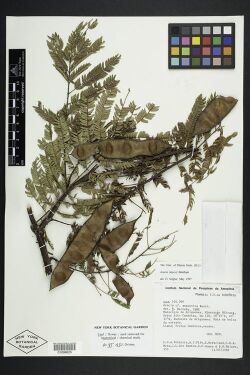Biology:Senegalia hayesii
| Senegalia hayesii | |
|---|---|

| |
| NY 0101098625[1] | |
| Scientific classification | |
| Kingdom: | Plantae |
| Clade: | Tracheophytes |
| Clade: | Angiosperms |
| Clade: | Eudicots |
| Clade: | Rosids |
| Order: | Fabales |
| Family: | Fabaceae |
| Subfamily: | Caesalpinioideae |
| Clade: | Mimosoid clade |
| Genus: | Senegalia |
| Species: | S. hayesii
|
| Binomial name | |
| Senegalia hayesii | |
| Synonyms[2] | |
|
Acacia acanthophylla (Britton & Rose) Standl. | |
Senegalia hayesii is a species of plant in the family Fabaceae.[2] It is native to Bolivia, Costa Rica, Guatemala, Honduras, Mexico, Panamá, and Venezuela.[2]
Description
Senegalia hayesii is a woody, clambering vine. The branches are a densely covered in very short soft hairs and have many small prickles. The bipinnate leaves are 30 to 40 cm. long, with 8 to 10 pairs of pinnae, each having 10-20 pairs of final leaflets. the midvein of the leaves is excentric. The flowers occur in spikes which are 10–12 mm long, and have calyces 2 mm long, with corollas 4 mm long.[3]
Taxonomy
It was first described by George Bentham in 1875 as Acacia hayesii,[2][4] from a specimen collected in Panama by S. Hayes,[4] and was redescribed in 1928 by Nathaniel Lord Britton and Joseph Nelson Rose as Senegalia hayesii.[2][3]
References
- ↑ "Senegalia hayesii NY 0102098625". GBIF. https://www.gbif.org/occurrence/1931027685.
- ↑ 2.0 2.1 2.2 2.3 2.4 2.5 Govaerts, R., et al. "Plants of the World online: Senegalia hayesii (Benth.) Britton & Rose". Board of Trustees of the Royal Botanic Gardens, Kew. 2020. https://powo.science.kew.org/taxon/urn:lsid:ipni.org:names:518260-1. Retrieved 2020-11-25.
- ↑ 3.0 3.1 3.2 Britton, N.L. & Rose, J.N. (1928). "Mimosaceae". North American Flora 23: 114. https://www.biodiversitylibrary.org/page/28528368.
- ↑ 4.0 4.1 , pp. 524, https://www.biodiversitylibrary.org/page/27558390, Wikidata Q104253514
Wikidata ☰ Q102543474 entry
 |

